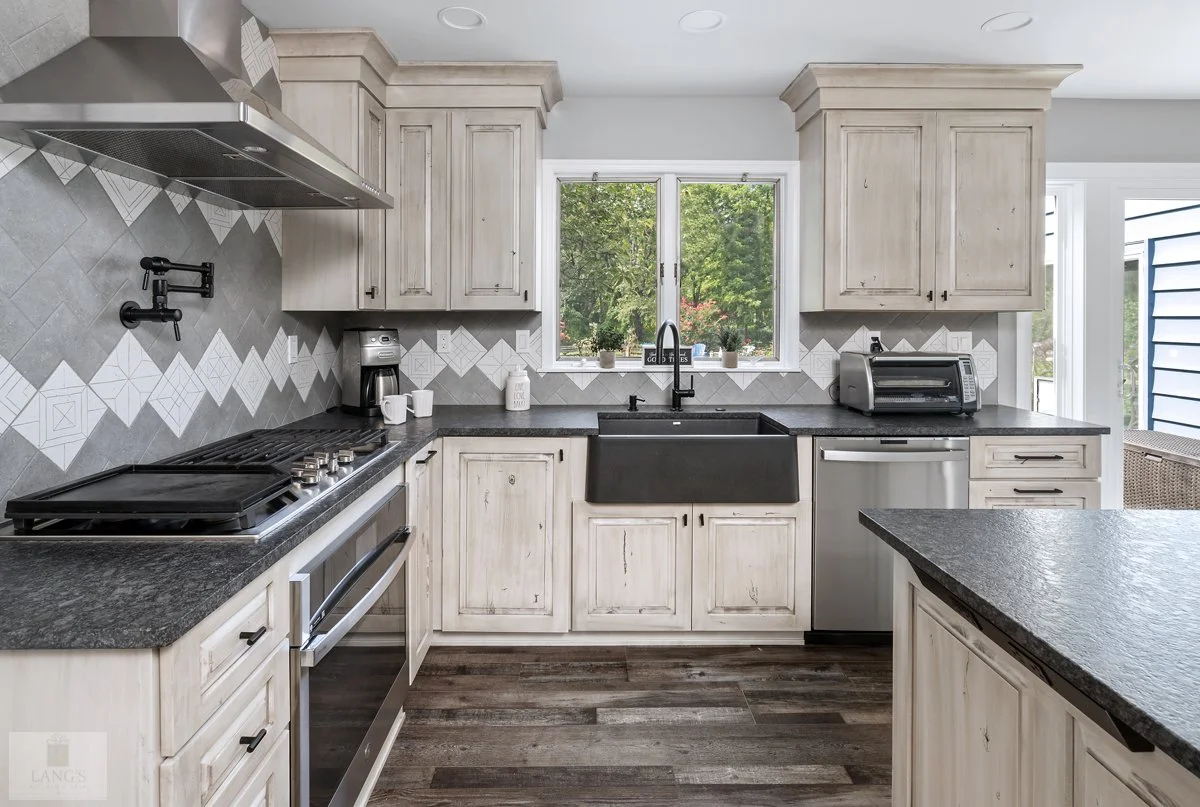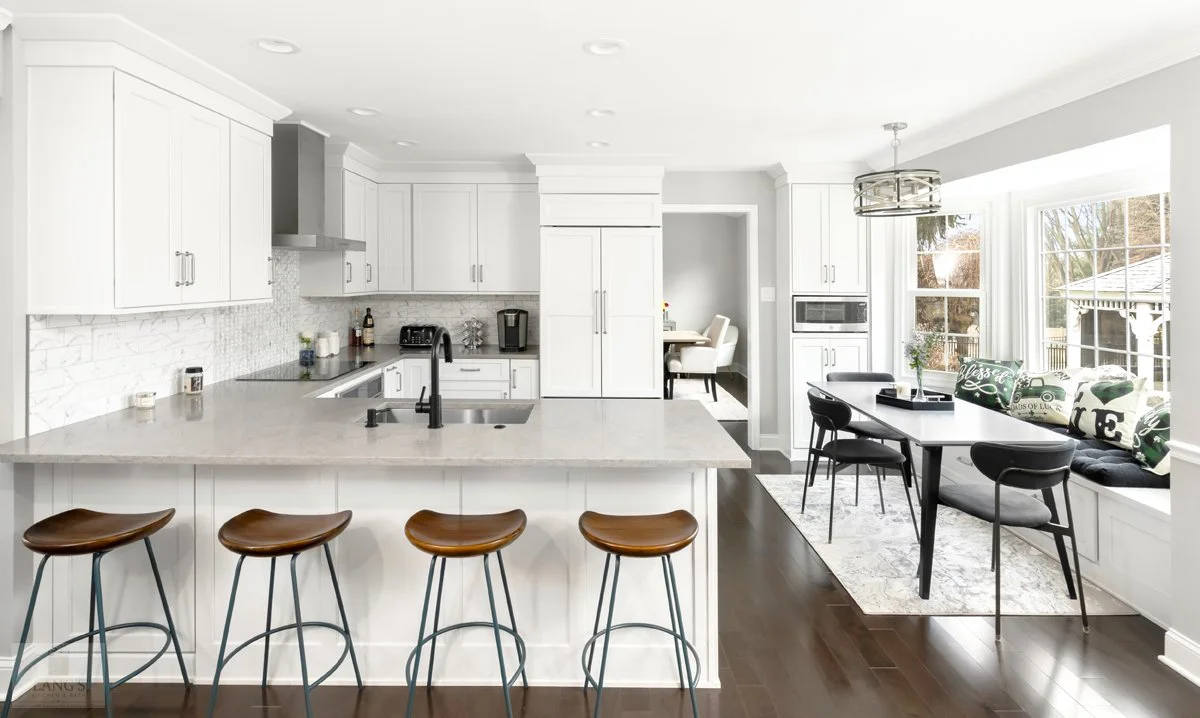From Lighting to Color Schemes and Beyond: How to Create the Perfect Mood for Your Kitchen
/Here is a new blog post from a guest author contributing to
Lang’s Kitchen & Bath’s website. All views expressed are those of the author.
Americans spend over 400 hours in the kitchen each year, according to a survey by OnePoll. With 77% saying they cooked with their family at least once a week growing up — creating some of their favorite childhood memories — there’s no doubt that the kitchen is a much-loved space for many. However, when aiming to create a space that emulates the right mood and feel, doing so successfully can seem like a challenge. From the value in assessing your goals beforehand to the power in details like lighting and color schemes, designing the kitchen of your dreams can be a creative endeavor for anyone who takes on the task.
Considering your preferences and goals beforehand
Before you begin making changes, writing out your goals for your dream kitchen is a must. This means you can ensure that each step you take in the redesign process is one that is working towards your overall vision, and it keeps you motivated and focused. Creating a mood or vision board is the perfect way to encapsulate your ideas for how you want your kitchen to ultimately look, while interactive design software can present a more accurate depiction of your ideas. Not only is this a great way to brainstorm and change things up (without the fear of commitment), but you’ll be able to get a visual idea as to what your choices will look like together, from the colors to the features and everything in between.
Accent lighting can make a noticeable difference
Lighting is a key aspect to any kitchen, though it can play a particularly important role in creating the right mood for the space, too. Kitchen lighting includes general lighting and work lighting. While general lighting (sometimes referred to as ambient lighting) involves the overhead lighting for the entire room, work lighting focuses on illuminating specific areas of the kitchen. Recessed lighting, for example, is noted to be “the classic solution” to a kitchen lighting problem as they provide extra lighting where needed without creating excess visual clutter.
Track lighting (which implements virtues of recessed lighting) and pendant lighting (which offer the benefit of being adjustable) are additional options to keep in mind, though setting the tone can be achieved in additional ways. When aiming to cultivate the right mood, it’s imperative to consider the temperature and brightness level in regard to lighting. Accent lighting provides a great opportunity for this and will add visual interest to the space while highlighting features of the room, according to one Homes & Gardens post. “Consider the “warm glow” areas where glazed cupboard lights can be left on to shine through glasses stacked on glass shelves to create an atmosphere while dining in the kitchen,” notes Alex Main, the director of The Main Company.
Choosing the perfect color scheme
Factoring in your goals for the ultimate kitchen is imperative when choosing the color scheme, especially when considering how much color can impact the overall mood of the space. In a literal sense, Mental Health America explains how colors in the home have the power to change mood via color psychology. For example, it’s noted that reds, oranges, and yellows (bright and warm colors), work to stimulate energy and happiness, while ‘cool, subdued colors’ like blues, greens, and purples, can be more calming. Green, for instance, is associated with nature — thus making it ideal for improving mood. Yellow, on the other hand, is explained to be an ‘intense, motivating color’ that promotes feelings of happiness and optimism. Mental Health America further goes on to note that bright and warm colors are “best in rooms for entertaining,” like the kitchen. However, there are additional factors to consider when cultivating the perfect mood in such a space.
When redoing your kitchen with the goal of changing the overall tone of the space, additions that complement the color scheme can make a notable difference. These include areas such as the backsplash, as well as wall paneling. For example, if you’re going for a nature-inspired, earthy kitchen with green paint, complementing the colors with wood paneling (which can be installed around a kitchen island, etc.) can further contribute to a natural looking and relaxing aesthetic. It’s imperative to note that wood paneling is ideal in various settings; while rough and textured wood finishes help create a rustic atmosphere, a lighter-finished wood can complement a modern-styled kitchen rather nicely. Similarly, a home with traditional decor will benefit from darker, warmer finishes when aiming to implement wood paneling. To further underline the value that wooden accents can have, wooden flooring (whether authentic or faux) and even cabinetry can have a great impact on the entire kitchen, creating a warm and inviting space that is conducive to rustic designs.
Functional (and decorative) details
In addition to the lighting and color scheme, details such as decor and design features will contribute greatly when adding the finishing touches to the perfect kitchen mood. Greenery, for example, can bring to life a kitchen, making for the ultimate finishing touch that injects an uplifting mood into the space. However, details that go beyond decor, have the power to take a kitchen to the next level — one Yardley, PA home showcases a marriage of form and function, with details that involve specialized storage and custom features like Walker Zanger decorative tile.
Functionality can play a major role in creating the perfect mood in your kitchen, in addition to cultivating a space that you’ll be drawn to use. This can be particularly beneficial when creating a fresh, clean, and minimalistic mood in a modern kitchen. For example, an indoor herb garden can be a major way to spruce up your kitchen while contributing to an earthy, fresh, and green aesthetic — and it’s able to be integrated into your cooking routine. If you’re going for a clean look that doubles as minimalistic, organization can be a great option, from pieces that double as decor such as glass canisters, a wooden spice rack, or a decorative box to hold favorite recipes.
Incorporating a personal touch
Adding personal touches throughout the kitchen is ideal when aiming for a space that is cohesive to a family space and will successfully bring tones of love and happiness to the room. For those who wish to display personal items, display options are certainly worth considering. Open-shelf storage, for example, is a great place to store knick-knacks and an epic recipe book collection, while shelves or glass cabinetry can showcase a sentimental china set. Creative additions can also work to cater to personal preferences — a space dedicated to coffee or tea is just one example of this, while creatively displaying a mug collection is another. Carving out a location to display an array of spices, or hot sauces are additional ideas that can cater to avid foodies.
Adding other personal items into the kitchen can further contribute to a homey and lived-in atmosphere, further working to create an uplifting and family-centered mood. Pictures of family and loved ones, favorite items (like a well-loved apron), and displaying your children’s artwork can all create an inviting kitchen. One design feature worth integrating is a family whiteboard (or blackboard). Whether for jotting down a grocery list or writing notes to one another, a family whiteboard can serve as a bonus functional design element that caters to any aesthetic — not to mention it can be further customized via marker colors, the addition of a family calendar, and magnetic features that are perfect for hanging up artwork, reminders, and other necessities.
Creating the perfect mood and overall aesthetic of a kitchen can seem like a challenging task — especially if you’re not sure where to start. By taking into consideration areas of interior design such as color scheme, decor, and lighting, however, creating the ultimate dream kitchen can be an easier process.





